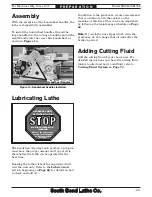
OPERATION
For Machines Mfg. Since 7/09
Model SB1016/SB1036
-31-
O P E R A T I O N
Operation Overview
Loose hair, clothing, or
jewelry could get caught
in machinery and cause
serious injury or death.
Keep these items away
from moving parts at all
times to reduce this risk.
During operation, small
metal chips may become
airborne, leading to serious
eye injury. Wear safety
glasses to reduce this risk.
To complete a typical operation, the operator
does the following:
1.
Puts on safety glasses, rolls up sleeves,
removes jewelry, and secures any clothing,
jewelry, or hair that could get entangled in
moving parts.
2.
Examines the workpiece to make sure it
is suitable for turning, then mounts the
workpiece in one of the chucks or on the
faceplate, and removes the chuck key from
the chuck.
3.
Mounts the tooling, aligns it with the
workpiece, then backs it away to establish a
safe startup clearance.
4.
Clears all tools from the lathe.
5.
Sets the correct spindle speed range for the
operation, and turns the spindle speed dial
all the way counterclockwise (to the lowest
speed) to avoid the possibility of damage
from a high speed start.
6.
Checks for safe clearances by rotating
the workpiece by hand at least one full
revolution.
7.
Moves slides to where they will be used
during operation.
8.
If using power feed, selects the proper feed
rate for the operation.
9.
Turns the master power switch
ON
,
resets
the stop button so it pops out, then moves
the spindle ON/OFF lever down to start
spindle rotation. The spindle will rotate
forward (the top of the chuck rotates toward
the operator).
10.
Turns the spindle speed dial clockwise to the
desired RPM.
11.
Uses the carriage handwheels or power
feed options to move the tooling into the
workpiece for operations.
12.
When finished cutting, moves the ON/OFF
lever to the center position to turn the lathe
OFF
,
then
removes the workpiece.
To reduce the risk of
serious injury when using
this machine, read and
understand this entire
manual before beginning
any operations.
The purpose of this overview is to provide
the novice machine operator with a basic
understanding of how the machine is used during
operation, so they can more easily understand
the controls discussed later in this manual.
Note:
Due to the generic nature of this overview,
it is not intended to be an instructional guide
for performing actual machine operations.
To learn more about specific operations and
machining techniques, seek training from people
experienced with this type of machine, and do
additional research outside of this manual by
reading "how-to" books, trade magazines, or
websites.









































